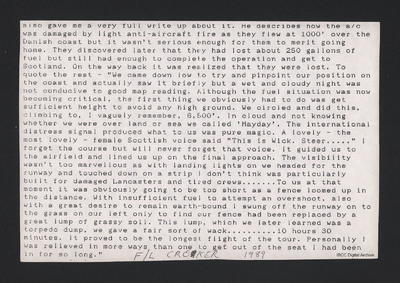Lost Lancaster Report
Title
Lost Lancaster Report
Description
A description of what happened to a lost Lancaster, short of fuel that was guided into RAF Wick and landed safely. Annotated 'F/L Crocker 1989'.
Date
1989
Temporal Coverage
Language
Format
One typewritten sheet
Publisher
Rights
This content is available under a CC BY-NC 4.0 International license (Creative Commons Attribution-NonCommercial 4.0). It has been published ‘as is’ and may contain inaccuracies or culturally inappropriate references that do not necessarily reflect the official policy or position of the University of Lincoln or the International Bomber Command Centre. For more information, visit https://creativecommons.org/licenses/by-nc/4.0/ and https://ibccdigitalarchive.lincoln.ac.uk/omeka/legal.
Contributor
Identifier
PWatsonC17010071
Transcription
also gave me a very full write up about it. He describes how the a/c was damaged by light anti-aircraft fire as they flew at 1000’ over the Danish coast but it wasn’t serious enough for them to merit going home. They discovered later that they had lost about 250 gallons of fuel but still had enough to complete the operation and get to Scotland. On the way back it was realized that they were lost. To quote the rest – “We came down low to try and pinpoint our position on the coast and actually saw it briefly but a wet and cloudy night was not conducive to good map reading. Although the fuel situation was now becoming critical, the first thing we obviously had to do was get sufficient height to avoid any high ground. We circled and did this, climbing to, I vaguely remember, 6,500’. In cloud and not knowing whether we were over land or sea we called ‘Mayday’. The international distress signal produced what to us was pure magic. A lovely – the most lovely – female Scottish voice said “This is Wick. Steer . . . . .” I forget the course but will never forget that voice. It guided us to the airfield and lined us up on the final approach. The visibility wasn’t too marvellous as with landing lights on we headed for the runway and touched down on a strip I don’t think was particularly built for damaged Lancasters and tired crews . . . . . . . To us at that moment it was obviously going to be too short as a fence loomed up in the distance. With insufficient fuel to attempt an overshoot, also with a great desire to remain earth-bound I swung off the runway on to the grass on our left only to find our fence had been replaced by a great lump of grassy soil. This lump, which we later learned was a torpedo dump, we gave a fair sort of wack . . . . . . . . . . 10 hours 30 minutes. It proved to be the longest flight of the tour. Personally I was relieved in more ways than one to get out of the seat I had been in for so long.” [inserted] F/L CROAKER 1989 [/inserted]
Collection
Citation
“Lost Lancaster Report,” IBCC Digital Archive, accessed November 14, 2024, https://ibccdigitalarchive.lincoln.ac.uk/omeka/collections/document/18552.
Item Relations
This item has no relations.

